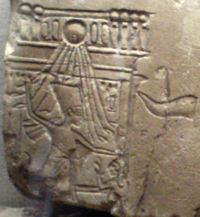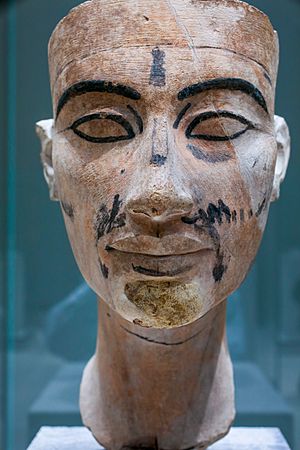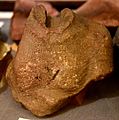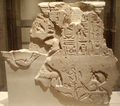Nefertiti facts for kids
Quick facts for kids Nefertiti |
|||||
|---|---|---|---|---|---|

The bust of Nefertiti from the Ägyptisches Museum Berlin collection, presently in the Neues Museum
|
|||||
| Queen consort of Egypt | |||||
| Tenure | 1353–1336 BC or 1351–1334 BC |
||||
| Born | c. 1370 BC Thebes, Egypt |
||||
| Died | c. 1330 BC | ||||
| Spouse | Akhenaten | ||||
| Issue |
|
||||
|
|||||
| Dynasty | 18th of Egypt | ||||
| Father | Ay (possibly) | ||||
| Mother | Iuy? (possibly) | ||||
| Religion | Ancient Egyptian religion | ||||
| Neferneferuaten-Nefertiti in hieroglyphs | ||||||||||||||
|---|---|---|---|---|---|---|---|---|---|---|---|---|---|---|
Neferneferuaten Nefertiti Nfr nfrw itn Nfr.t jy.tj Beautiful are the Beauties of Aten, the Beautiful one has come |
||||||||||||||
Nefertiti (born around 1370 BC, died around 1330 BC) was a powerful queen of Ancient Egypt. She was the Great Royal Wife of Pharaoh Akhenaten. She was also the mother-in-law of Pharaoh Tutankhamun. Some historians believe Nefertiti might have ruled Egypt herself after Akhenaten died. She may have used the name Neferneferuaten as pharaoh.
Her name means "the beautiful woman has come." Nefertiti was one of the most important queens in Egyptian history. She and Akhenaten ruled during a very rich time for Egypt. They made big changes to the country's religion. They focused worship on only one sun god, called Aten.
Nefertiti is famous for her beautiful bust, which is a statue of her head. This bust is now in the Neues Museum in Berlin. It is seen as a wonderful example of ancient Egyptian art. A sculptor named Thutmose likely created it. It was found in his workshop.
Contents
Nefertiti's Family and Early Life
Almost nothing is known about Nefertiti before she married Akhenaten. She was probably the daughter of a woman named Tey. Her father might have been Ay, who later became a pharaoh.
We don't know the exact dates of her marriage to Akhenaten. They had at least six daughters together. Their daughters included Meritaten, Meketaten, and Ankhesenpaaten. Ankhesenpaaten later married Tutankhamun and changed her name to Ankhesenamun. Their other daughters were Neferneferuaten Tasherit, Neferneferure, and Setepenre.
Nefertiti was Akhenaten's first and most loved wife. He had eight wives in total, but she was special. Akhenaten was very devoted to her beauty. Nefertiti was also very educated. She could read and write hieroglyphs, which was a rare skill back then.
Life as Queen of Egypt
Nefertiti first appears in ancient carvings in Thebes. These carvings show her with the new king, Amenhotep IV. They are both shown worshipping the sun god, Aten.
In Akhenaten's early years, he built several temples in Karnak. One temple, called the Mansion of the Benben, was for Nefertiti. Carvings there show her with her daughter Meritaten. Sometimes, princess Meketaten is also shown.
In the fourth year of his rule, Akhenaten decided to move the capital city. He moved it to a new city called Akhetaten. In his fifth year, Amenhotep IV officially changed his name to Akhenaten. Nefertiti then became known as Neferneferuaten-Nefertiti. This name change showed how important the worship of Aten had become.
The new city had many large temples built outside. Nefertiti and her family lived in the Great Royal Palace. They might have also lived in the Northern Palace. Nefertiti's household was managed by an official named Meryre II.
Sadly, Meketaten may have died around year 13 or 14 of Akhenaten's rule. Carvings show Nefertiti, Akhenaten, and three princesses mourning her. The last known writing that mentions Nefertiti and Akhenaten together is from year 16 of his reign.
Did Nefertiti Rule as Pharaoh?
Many experts think Nefertiti became a co-ruler with her husband, Akhenaten. This would have happened before he died. She is shown in many ancient artworks with the same power as a king. These images show her defeating Egypt's enemies. She is also shown riding a chariot and worshipping Aten like a pharaoh.
After Nefertiti's name disappears from records, a co-ruler named Neferneferuaten appears. This co-ruler was a female pharaoh. It seems likely that Nefertiti took on the role of pharaoh. She might have used the name Pharaoh Neferneferuaten after her husband's death. This would be similar to how the female pharaoh Hatshepsut ruled before her.
Some even think Nefertiti might have pretended to be a man. She could have used the male name Smenkhkare. If so, she might have made her daughter Meritaten her Great Royal Wife.
Death and Burial of Nefertiti
Nefertiti is believed to have died around 1330 BC. In 1898, an archaeologist named Victor Loret found two female mummies. They were in the tomb of Amenhotep II in the Valley of the Kings. These mummies were called 'The Elder Lady' and 'The Younger Lady'. People thought they might be Nefertiti.
However, later research used CT scans and DNA analysis. This research was led by Zahi Hawass. It showed that the Younger Lady was Tutankhamun's biological mother. She was an unnamed daughter of Amenhotep III and Tiye, not Nefertiti. The Elder Lady was identified as Tiye, Akhenaten's mother.
The KV21B Mummy
One of two female mummies found in another tomb, KV21, has been suggested as Nefertiti's body. DNA tests could not fully confirm this. However, they did show she was part of the Eighteenth Dynasty royal family.
CT scans showed she was about 45 when she died. Her left arm was bent over her chest, a pose often seen for queens. This idea comes from her being found with a mummy thought to be Ankhesenamun. It's possible that, like Tiye and the Younger Lady, a mother and daughter were buried together.
Letters from a Queen
A very old document was found in the Hittite capital of Hattusa. It dates back to Nefertiti's time. This document says the Hittite ruler received a letter from an Egyptian queen. The letter said:
My husband has died and I have no son. They say about you that you have many sons. You might give me one of your sons to become my husband. I would not wish to take one of my subjects as a husband... I am afraid.
This offer was very unusual. Queens from Egypt's New Kingdom usually did not marry foreign royalty. The Hittite ruler sent one of his sons, Zannanza. But the prince died on the way, perhaps murdered.
The queen who wrote this letter is not named. She is called Dakhamunzu in the Hittite records. This means "The King's Wife" in Egyptian. Since Nefertiti was shown as powerful as her husband, some historians think she might be the queen who wrote this letter.
Nefertiti's Many Titles
Nefertiti had many important titles, showing her high status. Some of these titles include:
- Hereditary Princess
- Great of Praises
- Lady of Grace
- Sweet of Love
- Lady of The Two Lands (meaning Upper and Lower Egypt)
- Main King's Wife, his beloved
- Great King's Wife, his beloved
- Lady of All Women
- Mistress of Upper & Lower Egypt
Images for kids
-
Nefertiti offering oil to the Aten.
-
A stone carving showing Nefertiti worshipping the Aten.
-
Akhenaten and Nefertiti.
-
Nefertiti presenting an image of the goddess Maat to the Aten.
-
Nefertiti and Akhenaten worshipping the Aten.
-
Boundary stone of Amarna with Nefertiti and her daughter, princess Meketaten.
Nefertiti in Pop Culture
Nefertiti has been shown in movies and TV shows:
- Geraldine Chaplin played Nefertiti in the 1973 Mexican short film Nefertiti and Akhenaton.
- Riann Steele played Nefertiti in the TV show Doctor Who (2012). She appeared in the episode called "Dinosaurs on a Spaceship."
See also
 In Spanish: Nefertiti para niños
In Spanish: Nefertiti para niños





















